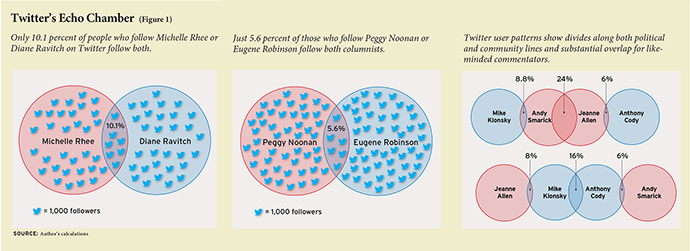People today are awash in news, commentary, analysis, and opinion. Whereas newspapers used to have a lock on the “public debate,” the field of play has now expanded infinitely, to incorporate blogs, Twitter, Facebook, and on and on. Anyone with a good idea, a flair for writing, and an Internet connection has a shot at influencing public opinion.
Yet amidst the flood of words and images, we information consumers are adapting in a predictable, if unsettling, way: migrating toward sources that share our underlying biases and prejudices, which is leading to less real dialogue and inevitably to greater polarization.
At least that’s the evidence from media researchers, who call this phenomenon “narrowcasting.” As columnist Nicholas Kristof put it in the New York Times a few years ago, “We generally don’t truly want good information—but rather information that confirms our prejudices. We may believe intellectually in the clash of opinions, but in practice we like to embed ourselves in the reassuring womb of an echo chamber.” Conservatives watch Fox; liberals watch MSNBC. Liberals read the New York Times, while conservatives peruse the editorial pages of the Wall Street Journal. Views become more extreme, as do the policies promoted by Republicans and Democrats alike.
Is this happening in the education policy debate, too? Are proponents and opponents of reform having a spirited conversation, or are we not even listening to one another?
To find out, I downloaded the lists of people who follow Michelle Rhee and Diane Ravitch, respectively, on Twitter. This is a far-from-perfect indicator, to be sure; with its 140-character limit, Twitter debates are notoriously shallow. But like the wise fool who searches for his keys under the street lamp because that’s where the light is, I used Twitter because that’s where the data are. (But Twitter is one of the fastest-growing sources of information and analysis in today’s media industry, and everyone’s Twitter followers are publicly available.)
Following someone on Twitter is not a high-commitment decision, unlike, say, pledging to read the editorial page of a newspaper with which you often disagree. So, one would think, there should be a fair amount of overlap in the followers of these two most outspoken “thought leaders” in education.
Is there? In short, no (see Figure 1). As of October 2012, Rhee had approximately 39,000 followers, Ravitch about 37,000. Yet only 7,052 people followed them both, or 10.1 percent of the total universe (the people who followed at least one of them).

Still, it’s hard to know what to compare this to. How narrowcast is that? Ten percent sounds low to me, but is it? So I also looked at two figures in the broader political debate. I chose columnists Peggy Noonan, a conservative, and Eugene Robinson, a liberal. Like Rhee and Ravitch, they have roughly the same number of followers (about 55,000 each). And how many followers do they share? Just shy of 6,000, or 5.6 percent of their total universe. Now the Rhee/Ravitch overlap doesn’t look any worse than polarization more generally.
Another illuminating comparison could be with the overlap of followers of two people with similar views. To make the math work, I needed to find two pairs of education thought leaders with roughly the same number of followers. (Rhee and Ravitch have such massive followings that it wasn’t possible to find appropriate matches for them.) So I chose Jeanne Allen and Andy Smarick to represent “conservative education reformers” and Anthony Cody and Mike Klonsky to represent “progressive opponents of reform.” Each of the four has about 3,000 followers. Allen runs the Center for Education Reform; Smarick is affiliated with Bellwether Education Partners and the Thomas B. Fordham Institute and served in the George W. Bush administration; Cody is a former Oakland teacher who blogs at edweek.org; and Klonsky is a former Students for a Democratic Society leader and an activist in the Chicago small-schools movement.
Sure enough, there’s strong evidence of narrowcasting. Whereas Cody shares just 6 percent of Twitter followers with Allen, and also 6 percent with Smarick, he and Klonsky have a 16 percent overlap. And whereas Allen shares just 6 percent of her followers with Cody, and 8 percent with Klonsky, she shares a whopping 24 percent with Smarick.
This narrowcasting isn’t just a matter of ideology. There’s something else at play in the education debate, too: a schism between the policy community on the one hand and practitioners on the other. Twitter users are asked to write short descriptions of themselves. More than 1,100 of Cody’s (3,000) followers use the word “teacher” or “educator” in their descriptions; for Allen, it’s just 400.
The bottom line is that there’s a whole lot of talking past one another in the education debate, though maybe less than in the political debate writ large. Want to be part of the solution? You might start by following on Twitter people whose views you abhor and staying open to the possibility that they might, nevertheless, have a few smart things to say.
Or you might follow Education Next; its followers overlap those of Rhee and Ravitch by roughly the same amount (11.7 and 10.8 percent, respectively).
This article appeared in the Spring 2013 issue of Education Next. Suggested citation format:
Petrilli, M.J. (2013). Tweet Thine Enemy: How “narrowcast” is the education policy debate? Education Next, 13(2), 78-79.


